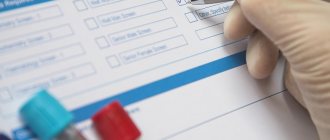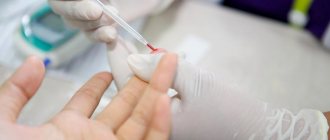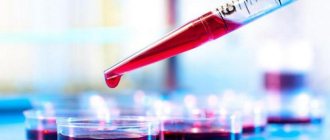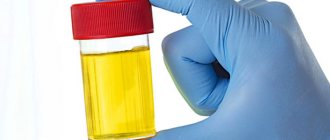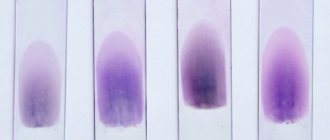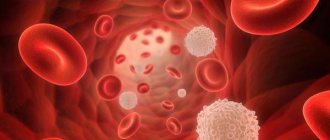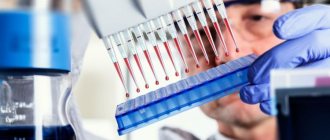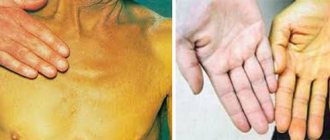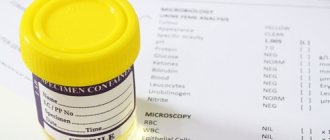Any pathological process in the body is reflected in blood counts. Therefore, a blood test from a vein is often one of the first diagnostic procedures that a doctor prescribes when a disease is suspected.
A blood test from a vein is more informative and accurate compared to a test of capillary blood from a finger. When taking blood from a finger, there is always the possibility of distortion of the results associated with the blood collection procedure itself. In addition, the volume of blood obtained from a finger prick test is often limited, so it may be difficult to double-check the results.
When is a general blood test prescribed?
A general blood test is prescribed in the following cases:
- As part of a routine annual medical examination to assess your current health status.
- If necessary, before starting any course of treatment, to monitor its effectiveness.
- In case of an infectious disease to clarify its nature.
Description of the blood collection procedure
To take blood from a vein, the patient's forearm is lightly tightened with a tourniquet. The patient is asked to clench and unclench his fist to increase blood flow. The skin in the elbow area is wiped with an alcohol wipe, after which a hollow needle is inserted into the vein. Through this needle, blood is drawn from a vein and the required number of tubes is filled.
After this, the needle is pulled out, and a sterile cotton swab is applied to the insertion site and secured to the arm with a bandage. After taking blood from a vein, you need to walk with such a bandage for no more than 5-7 minutes.
To determine different blood parameters, various methods, various reagents and equipment are used. Therefore, be prepared to fill several tubes depending on the required number of indicators.
What is included in a general blood test from a vein: indicators and norms
Reference values differ between laboratories. Such inconsistencies depend on which analyzer is used. You should focus on the standards used in a particular diagnostic center.
Normal indicators HOW
| Index | Reference values | |
| Hemoglobin (HGB) | In men – 130–160 g/l In women – 120–140 g/l | |
| Red blood cells (RBC) | In men – 4.0–5.0 × 1012/l In women –3.7–4.7 × 1012/l | |
| Hematocrit number (HT) | For men – 0.4–0.48 In women –0.36–0.42 | |
| Color indicator | 0,85–1,05 | |
| Reticulocytes | 0,2–1,2 % | |
| Erythrocyte sedimentation rate (ESR) | In men – 1–10 mm/hour In women 2–15 mm/hour | |
| Mean erythrocyte volume (MCV) | 86–98 fl | |
| Average hemoglobin content in erythrocytes (MCH) | 27–34 pg | |
| Mean erythrocyte hemoglobin concentration (MCHC) | 32–36 g/dl | |
| Width of distribution of red blood cells by volume | 11–15 % | |
| Platelets (PLT) | 180–320×109/l | |
| Platelet distribution width (PDW) | 10–20% | |
| White blood cells (WBC) | 4.0–9.0×109/l | |
| Leukocyte formula | Segmented neutrophils | 47–72% |
| Band neutrophils | 1–6% | |
| Eosinophils | 1–5% | |
| Basophils | 0–1% | |
| Lymphocytes | 18–37% | |
| Monocytes | 3–11% | |
Basic blood test indicators
Hemoglobin is a protein found in red blood cells. Its main function is to provide the body with oxygen. Both increased and decreased hemoglobin levels may indicate serious disorders: problems with the gastrointestinal tract, iron deficiency anemia, heart failure, etc.
Erythrocytes are red blood cells. Their excess can lead to thickening of the blood and the appearance of frequent headaches, dizziness, and nosebleeds. A low red blood cell count often leads to fatigue and tinnitus.
Reticulocytes are the precursors of red blood cells that are formed in the bone marrow. If their content is reduced, this may indicate a disruption in the formation of red blood cells. An increased content of reticulocytes may indicate the presence of blood loss.
Platelets are blood platelets responsible for blood clotting. A deviation of the platelet level from the norm may indicate the presence of serious diseases, such as tuberculosis, cancer of the liver and kidneys, bone marrow lesions, and leukemia.
ESR is the erythrocyte sedimentation rate. It may indirectly indicate the presence of an inflammatory process in the body.
Leukocytes are white blood cells. Their deficiency may indicate, among other things, the presence of an infectious disease.
Neutrophils are one of the types of leukocytes. Help the body fight bacteria. Their reduced content may indicate the presence of a severe infection in the body. If other blood parameters are normal, an increase in the level of neutrophils does not indicate the presence of serious problems in the body.
Lymphocytes are cells of the immune system. An increase in the level of white blood cells can be observed in children during the period of recovery from infectious diseases. A decrease in the content of lymphocytes in the blood is observed at the onset of the disease.
Monocytes are a type of white blood cell. Their function is to cleanse the body and support the immune system. An increase in their content may indicate an inflammatory or oncological disease.
Eosinophils are white blood cells responsible for destroying foreign protein in the body. They are elevated in allergic diseases.
Basophils are white blood cells, an increase in the content of which may indicate the presence of an inflammatory process or a foreign body in the body, as well as inflammation in the digestive organs and disruption of the thyroid gland.
Plasmocytes are cells that are part of the immune system and are responsible for the production of immunoglobulins (antibodies). They may appear in the blood during infectious diseases such as chickenpox, rubella, and measles.
Biochemical analysis
A biochemical blood test from a vein is performed to assess the functioning of organs and systems. This fluid contains not only cells, but also chemicals that cannot be detected even under a microscope. For a general study, this data is not needed: for biochemistry, blood is taken only if pathologies of internal organs are suspected. To understand what types of tests there are, it is important to understand what is in its composition.
- Proteins (normally 60-85 g/l) - their total amount is determined. It can increase with dehydration, infectious or allergic diseases. A decrease in protein concentration is the result of tumor processes, acute and chronic pathologies of the gastrointestinal tract.
- Lipids (4.5-7 g/l) - the total amount can be increased in case of liver disease or diabetes. Cholesterol is determined separately: its normal level is 3-6 g/l. Its increase indicates atherosclerosis and can be observed during pregnancy. Decreased cholesterol is a sign of thyroid deficiency.
- Glucose is one of the most important indicators. The normal blood sugar level is 3.5-5.5 mmol/l. An increase in this indicator is dangerous and indicates pathologies such as diabetes mellitus and thyroid dysfunction. It is worth understanding that sugar levels are not constant and may increase after eating.
- Vitamins and inorganic compounds: chlorine, calcium, potassium, iron, sodium and others. These data are necessary only if there is a suspicion of hypo- or hypervitaminosis, deficiency or excess of minerals.
- Nitrogenous substances are an indicator of kidney function. Thus, urea (2.6-6.4 mmol/l) and creatinine (from 53 to 97 mmol/l for women, from 62 to 115 mmol/l for men) increase with renal failure and urinary outflow disorders, and may also indicate myocardial infarction.
- Bilirubin is a copper-containing pigment. The normal level of total bilirubin is 5-10 µmol/l; direct and indirect fractions can also be determined. Its increase indicates liver dysfunction, blood loss, poisoning and infectious diseases, which are accompanied by the destruction of red blood cells.
- Enzymes - by their activity one can judge the functioning of internal organs. Thus, aminotransferases increase with liver inflammation, muscle damage or myocardial infarction. No less acute conditions cause an increase in the activity of lactate dehydrogenase and creatine phosphokinase.
REFERENCE! A separate increase in one or more indicators, without a clear clinical picture of the disease, is not yet a reason for making a diagnosis. Examinations include ultrasound diagnostics and other methods.
Preparatory activities
Special preparation for a general blood test has not been developed to date, due to the simplicity of the laboratory procedure. Despite this, clinicians insist that patients adhere to the following simple recommendations:
- refusal to consume fatty foods the day before the test;
- complete elimination of bad habits 3 days before the examination;
- if you have menstruation on the day of the procedure, it is strongly recommended to postpone the analysis - if this is impossible for any reason, the hematologist will take this factor into account when interpreting the results;
- If you are taking this or that drug, you should inform your specialist.
The most important rule concerns the consumption of food on the day of a direct visit to the clinic for a general clinical analysis - it does not matter whether the blood is taken from a vein or from a finger.
It must be taken into account that blood sampling is performed strictly on an empty stomach. This is explained by the fact that some products can affect the concentration of formed elements, as a result of which the possibility of false research results cannot be ruled out.
There are no restrictions regarding the ingestion of liquids (except for drinking alcoholic beverages). It is noteworthy that if OAC is prescribed to a child, no preparatory measures are needed.
The main difference between studying blood from a vein or from a finger is only in the number of indicators and some features of the removal of material for laboratory samples.
Preparation process
Before a laboratory test, it is appropriate to consult a doctor to find out up-to-date information about what this procedure is and what such an analysis can show. Interpretation of the results is the responsibility of a person with appropriate qualifications.
How to prepare for the test:
- On the eve of the test, avoid mental stress and physical exertion.
- Do not suddenly change the daily routine to which you are already accustomed, and the composition of your diet: the body will be stressed.
- Most often, the procedure is carried out in the morning and on an empty stomach. Before taking blood, you can drink clean water and do not smoke.
- If you need to take any medications for medical reasons, ask your doctor in advance whether they can be taken before the procedure.
- In extreme heat, it is better to postpone this event.
Healthy people are recommended to undergo this test at least once a year.
Reference! If you take the test after 11 am, there is a possibility of getting an inaccurate result.
FAQ
Is it necessary to donate blood from a vein on an empty stomach?
Food consumption should be no later than 8-12 hours before sampling. This is the time of assimilation, after which processes in the body are normalized.
Food intake affects the following indicators:
- glucose content
- enzyme activation;
- increasing the concentration of proteins and fats;
- change in viscosity;
- increase in hormonal saturation.
Food can cause false positive results, which is why you need to donate blood from a vein on an empty stomach. If this is not possible, collection is allowed at other times of the day, maintaining an interval of 6-8 hours from meals.
Can I drink water before donating blood?
There are no contraindications to drinking regular drinking water. Its composition has no effect unless sweeteners and dyes are used.
Is it possible to brush your teeth before donating blood?
If a biochemical analysis is prescribed, it is better to refrain from morning oral hygiene. It is not recommended to brush your teeth when testing for sugar, glucose, or urea. The paste contains triclosan, which affects the accuracy of the results obtained. Saccharin increases glucose levels. Foaming pastes can change the protein composition.
When taking hormone tests, there are no restrictions on brushing your teeth.
What time do you donate blood from a vein?
Usually the procedure is carried out from 8:00 to 10:00. This is the optimal time - 2 hours should pass after waking up. Before taking the test, a person should not experience physical exertion or become emotionally excited, so the morning is the best time. If you climbed the stairs, it is advisable to rest for 15 minutes. After the test, you can take the prescribed medications and have breakfast.
When should you not donate blood from a vein?
There are factors that distort the results. The procedure must be rescheduled if you:
- experienced increased physical activity and stress the day before or on the day of the test;
- took blood thinning medications unless specifically directed by a doctor;
- ate food less than 8 hours before the procedure.
How often can you donate blood from a vein?
This question worries people who need constant monitoring of indicators. Pregnant women and patients undergoing hospital treatment sometimes have to be tested every day. Don’t worry, the volume taken from a vein at a time is too small to have a negative effect on the body. Most patients do not notice blood loss.
What can be detected in a venous blood flow analysis
Why do you need to donate blood from a vein for laboratory tests and what can you learn from it? And also, what exactly is venous blood material used for? After taking blood from a vein, it is easy to determine the content of the hormonal, immunological, cellular and biochemical composition of the blood mass. And thanks to comprehensive information data, it is possible to detect any disease.
- A biochemical study of venous blood flow clarifies the main biological components, such as proteins, enzymes, electrolytes, lipids, glucose. The ratio of these blood substances helps in determining diseases of the cardiovascular system, oncological processes, liver pathologies and other health abnormalities.
- The study of hormonal balance using a sample of blood substance provides information regarding the level of certain hormones. Thanks to which it is easy to detect which organ or system is failing, because each hormone in the human body is responsible for strictly defined functions. As a rule, hormonal imbalance indicates a disruption of the endocrine system, metabolism or gastrointestinal tract.
- An immunological study of venous blood flow makes it clear about the state of humoral and cellular immunity. The body's defense system produces various antibodies in response to a pathogen that has entered the human body. Depending on the specific immunoglobulin, it is enough to simply calculate which organ was attacked by foreign microorganisms.
Taking blood from a vein allows not only to identify a specific pathology. The study provides an opportunity to find out what stage of development (initial, active, initial) and form (acute, chronic) the disease is in. This information is extremely important when prescribing a course of treatment. But only blood fluid analysis, for which careful preparation has been carried out, has such a high degree of information content and reliability.
Why is blood taken from a vein for analysis?
Everyone knows how important quantitative and qualitative blood tests are for making an accurate diagnosis. But many people wonder why they take blood from a vein and not from a finger. After all, in essence, the blood substance in the human body, no matter where you take it from, is the same, except for the color - the venous substance is darker. This statement is true. But it is necessary to take into account that the saturation of formed elements and other organic substances, including aggressive antigens, if present in the body, in the veins and capillaries is significantly different.
During a medical examination or whenever a person comes to the clinic with complaints of simple ailments, he is asked to donate blood from a finger prick. This event is carried out in order to quickly obtain the result of the analysis and make sure whether there is really a reason to seriously worry.
A general analysis of capillary blood, obtained by collecting biomaterial from the ring finger, makes it possible to obtain information about the cellular components of the blood flow and the quantitative indicator of ESR.
Such data can be useful in diagnosing bacterial or viral infections, inflammatory processes, and pathological blood abnormalities. If, based on a blood test from a finger, the doctor determines a deviation from the norm of blood flow particles, which indicate the development of some pathological process. Then, after an additional examination, the patient will be prescribed a detailed blood test from a vein.
Rules for analyzing blood samples from a vein
From which arm is blood taken and how to donate blood to get high-quality test results? Blood is taken from a peripheral vein in the elbow area. Before donating blood from a vein, it is necessary to prepare the body properly. The basic rules for collecting blood from a vein are generally accepted. But there are some special recommendations when analyzing blood flow for certain types of pathologies.
The generally established procedure for collecting blood from a vein:
- On the eve of the day of blood flow analysis, it is necessary to refrain from difficult-to-digest, too high-calorie, fatty, fried, heavily seasoned, salted, pickled and other foods that are difficult for the digestive system.
- A blood sample from a vein is taken on an empty stomach. More than 6–7 hours should have passed since the last time you ate food. Drinking water in the morning is not only allowed, but also desirable to thin the blood so that it is easier to take.
- Donating blood from a vein is not recommended if research physiotherapeutic measures, namely ultrasound, MRI, X-ray, tomography and others, were carried out in the coming days.
- Taking blood material from a vein is prohibited if the patient is undergoing or has recently undergone a strong emotional experience. Physical overexertion also distorts its indicators. Therefore, it will be necessary to reschedule the blood fluid test for people who are experiencing stress or are in a state of severe fatigue.
- If the patient is undergoing a course of drug treatment, then the doctor who prescribes the analysis of blood flow from the vein should be informed about the intake of drugs, specifying which ones exactly.
- To obtain correct venous blood flow tests, you will have to abstain from drinking alcoholic beverages for at least a week. And on the day of visiting the laboratory, do not smoke for at least two hours before taking blood samples from a vein.
- If there is a need to re-test the blood substance, the patient must adhere to the same preparation conditions, that is, observing the same time as during the initial blood draw, a similar diet and all the other points listed above. For women who undergo specific tests of venous blood flow, the phase of the menstrual cycle, the presence of pregnancy, and the state of menopause are important. These factors are especially important to take into account when taking blood samples for hormones. After donating blood from a vein, it is better to sit in the lobby of the diagnostic center so that the blood flow normalizes. When going to the laboratory in the morning, it would be a good idea to take something to eat and drink with you in order to restore your energy supply after the procedure.
How to prepare for the analysis?
Taking material for analysis from the venous bed allows you to evaluate the biochemical and general parameters of the blood. To reduce the errors in the results, you must adhere to the following rules during preparation:
Blood should be donated on an empty stomach;
The day before the test, you should avoid fatty foods;
you need to stop taking medications as recommended by your doctor;
It is advisable to refrain from smoking and drinking alcoholic beverages for 24 hours.
It is important to remember that the result is also influenced by the time of collection, reagents and laboratory equipment.
How is blood taken?
The correctness of the examination results depends on the technique of collecting blood for analysis from a vein. This in turn affects the diagnosis, and subsequently the correctness of therapy. Compliance with the instructions for taking a sample prevents the occurrence of negative consequences that may arise if the algorithm is violated.
If a patient is wondering whether it is painful to donate blood from a vein, then his feelings depend on the professionalism of the laboratory assistant. One of the complications of an incorrect through puncture can be a hematoma in the elbow area. If a clinic worker does not follow the rules of asepsis, this can cause inflammation of a peripheral vessel (phlebitis). And the worst thing is blood poisoning (sepsis).
To take biomaterial, the following tools are used: a needle, a tourniquet, a syringe (disposable), or a vacuum-type device. The needle is needed for the direct outflow of blood into a container - a test tube. This method is already practically irrelevant, since it is inconvenient, painful, causes panic fear (phobia) and leaves the risk of blood coming into contact with the hands of doctors and other non-sterile things.
Drawing blood into a syringe is used in closed laboratory rooms of public clinics. The big disadvantage of this method is the need to use additional instruments (test system, glass tube), and the risk of blood hemolysis.
Modern centers use new vacuum instruments for receiving venous blood called “vacutainer”. They consist of a vacuum tube, a catheter, a thin needle, a holder, a container and a special reagent. As reviews have shown, such tools are painless and convenient. Bloodletting occurs safely. You can no longer be afraid of this procedure and no longer faint from pain.
The video below shows how a sample is taken from a vein:

